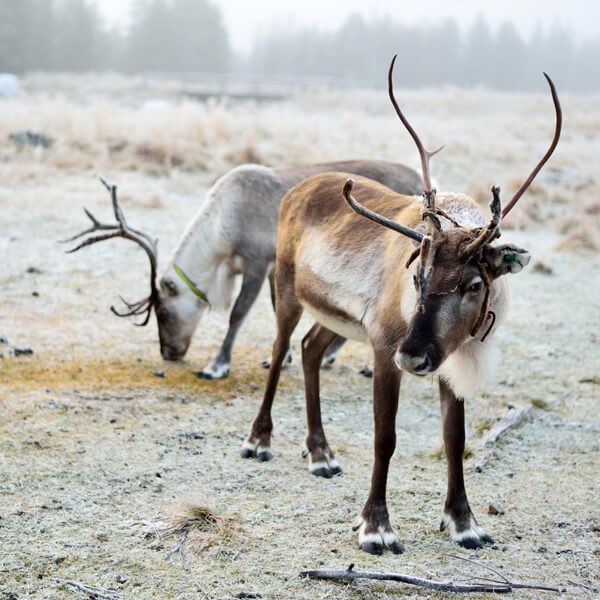
A satellite image shows how a decades-old fence erected between Finland and Norway affected Arctic vegetation by altering the movement of reindeer herds.
CREDIT: ANNUAL REVIEW OF ENVIRONMENT AND RESOURCES 2017
Fences tend to be invisible on satellite images — you won’t see one in the image above, no matter how much you squint. Yet even without the labels, it would be easy to make out where the governments of Norway and Finland built a border fence back in the 1950s. In atlases, countries are different colors, of course. But in real life? How can that be?
The explanation is in the vegetation, says Bruce Forbes, a geoscientist at the University of Lapland in Finland and coauthor of a paper in the Annual Review of Environment and Resourceson ways that people are altering ecology in the Arctic. “Since this is a satellite image, the colors are false,” Forbes first says of this 2001 picture, plucked from the paper. But, he adds, the hues represent real wavelengths of light, some of them invisible to the human eye. And their patterns reveal large differences in the local vegetation that might spell trouble for the future.
Forbes knows what the colors correspond to, since he’s been out in the field many times to check what the satellite data mean and to conduct experiments. The black areas, he explains, are bodies of water. The red patches are covered in mosses and vascular plants such as grasses, sedges and shrubs — most of them in low-lying wetlands. Brightness reveals vegetation quality: Dull red means plants are short, while intense red indicates a certain lushness — usually tall shrubs. “That really bright-red patch next to the lake north of the fence? That’s the lushest vegetation,” Forbes points out. “Those willow shrubs may reach up to my waist.” (In most of the Arctic, willows never make it to full tree size.)
South of the fence, the duller red indicates that most willows in northern Finland aren’t even shrub-sized. They’ve been grazed down to the ground by reindeer, which are present in higher densities in northern Finland than they are on the other side of the fence, in Norway. But perhaps we shouldn’t weep for the willow, nor rein in the reindeer. Many scientists and environmentalists have expressed concern that rapid climate warming may cause Arctic shrubs to thrive, resulting in a “shrubification” of the landscape.
Such shrubification might give rise to a vicious cycle, Forbes says. Since shrubs are darker than the other Arctic vegetation, they absorb more sunlight. This may cause more snow to melt more rapidly. If that happens, the surface will become even darker, and that could speed up warming even more. Grazing reindeer may help to nip shrubification in the bud, which could slow down local warming trends.
But there’s a problem: Reindeer throughout the Arctic are struggling due to climate change.
“Warmer temperatures mean that the air is more humid,” says Forbes. “This leads to more snowfall, which makes it harder for the reindeer to dig up the lichens they feed on in winter. It might even rain on the snow, which can then freeze over and turn into ice that the reindeer can’t dig through.” This has caused the deaths of tens of thousands of reindeer across the Arctic in recent decades.

Grazing reindeer in Finnish Lapland.
CREDIT: TATU EERO ANTON LAJUNEN / ALAMY STOCK PHOTO
And there’s more. In northern Finland, other problems compromise the reindeer’s ability to find food in winter. Again, the satellite image tells the story: Grayish areas on the Finnish side of the fence are mostly bare ground — the lichens gone, trampled by reindeer in the summer when they are dry and brittle and crumble very easily.
It looks, then, as if the fence has at least protected the lichens of Arctic Norway, by keeping the lichen-stomping reindeer out. But it’s not so simple, Forbes says. Once upon a time, the reindeer would migrate north and south at will, and would hang around in northern Finland only in the winter. Come summer, they’d head further north to forage in the wetlands on the coast of Norway. The result was that fewer lichens got trampled, both in Finland and Norway.
Then came the building of the fence, part of a 1950s government effort to enforce the borders and compel the local Sámi herders — who used to follow the migrating reindeer — to settle. And so the migration route was blocked.
The most obvious solution might be to remove the fence and allow the reindeer (and herders) to migrate as they traditionally used to. But Forbes thinks that is unlikely to happen: “I’m afraid the border fences are there to stay,” he says. So what can be done? Forbes believes the Sámi could still help to make reindeer herding more sustainable — if policymakers would consult them more often. And if damage to lichens could be minimized, grazing reindeer might be an eco-friendly way to keep shrubification at bay.
Indeed, some spots where shrubification is on the rise used to have more reindeer herding, and today’s lusher vegetation may be due, in part, to the local disappearance of this traditional way of life. But climate change is also important, as there are changes all across the Arctic. “Arctic ecosystems change at a fairly glacial pace,” says Signe Normand, an ecologist at Aarhus University in Denmark and first author of the review article. “They are slow to respond to new conditions and slow to recover when disturbed.” That lag between our actions and their consequences buys some time to intervene, she says. “But it can also make us complacent.”




